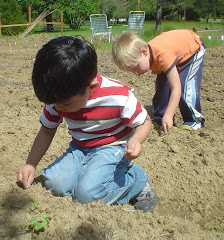 |
| Jim husks blue corn. |
Our first corn crop was in the summer of 2015. We'd been given a small, shriveled ear at a seed-swap. The corn was already two years old and, since corn seed degrades faster than most, we weren't sure how viable it would be. In this case we pre-sprouted it and only planted seeds that germinated. Our young friend Serenity patiently and diligently planted the corn in cultivated soil -- 5" apart and 1" down, gently covering the seeds with soil as she went.
We have a lot of blue-jays in our neighborhood, and some crows - both who love corn! One year we planted corn, saw the new seedlings sprout above-ground in the afternoon -- a whole long, row of them, came back the next morning and discovered that each and every one had been dug up and eaten! So, to prevent this happening again we covered our newly planted corn with 'floating row cover' (brand-name: "Reemay") a synthetic, white cloth that lets rain and sunlight reach the plants but protects them from light frosts and hungry garden-creatures! Reemay must be pinned in place, or held down with bricks or stones. It can be left on till seedlings start pushing at it from below at which point it's unlikely that birds/animals will dig up and eat your plants.
 |
| Covered row cloth protects young crops from mild frosts and animals that might eat the tender, new plants. Remove once plants are pushing up on bottom of cloth. (Pic credit) |
The soil we planted in was fairly poor and newly tilled so once the seedlings were a few inches above-ground, we gave them a thorough soaking with compost-tea.
 |
| Compost tea is steeped in large batches and then poured generously on crops to fertilize them. |
 |
| The orange string (around bed to left of hose) is used to mark newly planted soil so no one walks on it by accident. |
 |
| Shucking corn and shelling beans are a favorite autumn activity at the Sharing Gardens. |
 |
| In this picture, corn has finished ripening, and partially drying on the stalk. Christie harvests the ears to be husked and further dried in our greenhouse. |
 |
| Christie and Chelsea remove husks and lay cobs onto a drying table to continue to dry. Corn is easiest to remove from the cobs if it is dried well. |
Shucking can be done simply by twisting the cobs in your hands to break loose the kernels (you might want to wear gloves!). If you have a lot of shucking to do, here's a simple tool Chris made that really speeds up the process!
 |
| Home-made corn-shucker. The cob is twisted against protruding screws. |
 |
| A tub of dried corn-kernels. |
Grinding corn: Obviously, if you're growing your own corn for grinding, you're going to need a grain-mill! After carefully comparing reviews of different brands and models, we chose to invest in a top-of-the line Diamant grain-mill. This is considered an 'heirloom' appliance in that, with proper care it will last for generations. Ours came with a handle for hand-grinding, can be hooked up to a bicycle for larger, human-powered batches or hooked up to a small motor (which is what we did) so we can grind large batches with ease. If the price-tag is prohibitive, consider purchasing one with your neighbors and setting it up in a central location for all to share.
 |
| Mill hooked up to motor for faster grinding. It comes with a handle, for hand-grinding and we also have seen instructions for hooking it up to a stationary bicycle. |
 | |
| Close-up view of Diamant grain-mill. The 'can' on top has an open bottom and allows us to pour more grain in at a time. The knob at left adjusts the fineness of the grind. |
 |
| Close-up of mounted engine. |
Obtained from Native Americans in the Pacific NW (Washington state, USA) in the 1950's. It is an Heirloom, non-hybrid variety that will "grow-true" year-after-year so you can save your own seed.
Description: 75-80 days - to maturity. The 4-4 1/2 foot stalks produce 5-7 inch ears of some of the finest tasting corn. Ears typically have 10-12 rows of kernels that dry blue-black upon maturing - 1 or 2 ears per plant LINK - Reviews of Growers.
Why we like it: Does well in a cooler, damper climate. Because of its short-stalk, it won't 'lodge' (fall over) as taller varieties sometimes do. Grinds into the sweetest cornmeal! Can be as much as 30% higher in protein than regular 'sweet-corn' LINK-nutritional facts.
Favorite recipes: Hooker's Blue corn is deliciously sweet and nutty-flavored. Here are some ideas for using it in recipes.
Hot cereal: Stir ground corn into lightly salted water in a 2:1 ratio (twice as much water as corn). Gently heat the corn and water together, stirring occasionally and simmer on low heat, in a covered pan for ~20 min.
Crumb-Free Whole Grain Corn Bread: We make a large batch of the dry-mix ahead of time so it's easy to just add milk, eggs and oil for a quick batch of corn bread or pancakes. Yum! LINK-Recipe
Whole Grain No-Knead Bread: We've adapted Jim Lahey's delicious no-knead bread-recipe to incorporate whole wheat flour and blue-corn meal. So tasty and nourishing! LINK-Recipe
Scarlet Runner Beans: Here is a post about "Growing Your Own Protein - Scarlet Runner Beans" - LINK. Beans and corn together give you all the essential amino-acids needed in one meal (a complete protein) and it's delicious too!
 |
| Beautiful scarlet runner bean blossoms! |









































No comments:
Post a Comment